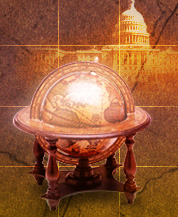 |
||
  |
||
|
|

|
||
U.S. History - Native American: Lesson Plans
| Anishinabe - Ojibwe - Chippewa: Culture of an Indian Nation
This lesson focuses on one American Indian Nation, the Anishinabe, also known as the Ojibwe, Ojibway, or Chippewa Indians. Students will learn how to conduct a research project on different historical, geographical, and cultural aspects of this Native American group.
|
| Choosing Sides: The Native Americans' Role in the American Revolution
Native American groups had to choose the loyalist or patriot cause—or somehow maintain a neutral stance during the Revolutionary War. Students will analyze maps, treaties, congressional records, first-hand accounts, and correspondence to determine the different roles assumed by Native Americans in the American Revolution and understand why the various groups formed the alliances they did.
|
| Common Visions, Common Voices
Trace similar motifs in the artwork and folklore of India, Africa, the Maya, and Native Americans.
|
| I Hear the Locomotives: The Impact of the Transcontinental Railroad
Students analyze archival material such as photos, documents, and posters, to understand the phenomenon of the Transcontinental Railroad.
|
| Images of the New World
How did the English picture the native peoples of America during the early phases of colonization of North America? This lesson plan will enable students to interact with written and visual accounts of this critical formative period at the end of the 16th century, when the English view of the New World was being formulated, with consequences that we are still seeing today.
|
| Kennewick Man: Science and Sacred Rights
Explore the controversy sparked by the discovery of a prehistoric skeleton.
|
| Life on the Great Plains
Examine the history and geography of a region that has been at the heart of the American experience.
|
| Mapping Colonial New England: Looking at the Landscape of New England
The lesson focuses on two 17th century maps of the Massachusetts Bay Colony to trace how the Puritans took possession of the region,
built towns, and established families on the land. Students will learn how these
New England settlers interacted with the Native Americans, and how to gain
information about those relationships from primary sources such as maps.
|
| Native American Cultures Across the U.S.
This lesson discusses the differences between common representations of Native Americans within the U.S. and a more differentiated view of historical and contemporary cultures of five American Indian tribes living in different geographical areas. Students will learn about customs and traditions such as housing, agriculture, and ceremonial dress for the Tlingit, Dinè, Lakota, Muscogee, and Iroquois peoples.
|
| Not 'Indians,' Many Tribes: Native American Diversity
Students study the interaction between environment and culture as they learn about three vastly different Native groups in a game-like activity that uses vintage photographs, traditional stories, photos of artifacts, and recipes.
|
| On This Day With Lewis and Clark
Looking at historic maps of the West, students can begin to appreciate the immensity and mystery of the mission Lewis and Clark accepted.
|
| Other Worlds: The Voyage of Columbus
Meet the people whose encounter with Columbus led to the creation of a New World.
|
| The Monroe Doctrine: Origin and Early American Foreign Policy
Curriculum Unit overview. Monroe brought a vision of an expanded America to his presidency—a vision
that helped facilitate the formulation of what has become known as the Monroe
Doctrine. In this unit, students will review the Monroe Doctrine against a background
of United States foreign relations in the early years of the republic.
Lesson 1: The Monroe Doctrine: U.S. Foreign Affairs (circa 1782-1823) and James Monroe
Lesson 2: The Monroe Doctrine: President Monroe and the Independence Movement in South America Lesson 3: The Monroe Doctrine: A Close Reading Lesson 4: The Monroe Doctrine: Whose Doctrine Was It? |
| Traditions and Languages of Three Native Cultures: Tlingit, Lakota, & Cherokee
This lesson compares the cultures and languages of the Tlingit, Lakota, and Cherokee American Indian tribes, and helps students learn the importance of preserving a group's traditions.
|
| What Should a House Do?
Students will look closely at the design, construction and materials of at least one Native American house and one house built by European settlers to understand why houses are designed the way they are.
|
| William Penn’s Peaceable Kingdom
By juxtaposing the different promotional tracts of William Penn and David Pastorius, students will understand the ethnic diversity of Pennsylvania along with the “pull” factors of migration in the 17th century English colonies.
|
| Women’s Suffrage: Why the West First?
Students compile information to examine hypotheses explaining why the first nine states to grant full voting rights for women were located in the West.
|
  |
||
| EDSITEment contains a variety of links to other websites and references to resources available through government, nonprofit, and commercial entities. These links and references are provided solely for informational purposes and the convenience of the user. Their inclusion does not constitute an endorsement. For more information, please click the Disclaimer icon. | ||
| Disclaimer | Conditions of Use | Privacy Policy Search
| Site
Map | Contact
Us | ||
